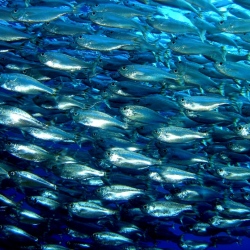
An international team of marine biologists has found mesopelagic fish in the earth’s oceans constitute 10 to 30 times more biomass than previously thought. UWA Professor Carlos Duarte says mesopelagic fish, fish that live between 100 and 1000m below the surface, must therefore constitute 95 per cent of the world’s fish biomass.
"Because the stock is much larger it means this layer must play a more significant role in the functioning of the ocean and affecting the flow of carbon and oxygen in the ocean," he says.
Prof Duarte led a seven-month circumnavigation of the globe in the Spanish research vessel Hesperides, with a team of scientists collecting echo-soundings of mesopelagic fish.
He says most mesopelagic species tend to feed near the surface at night, and move to deeper layers in the daytime to avoid birds. They have large eyes to see in the dim light, and also enhanced pressure-sensitivity.
"They are able to detect nets from at least five metres and avoid them," he says. "Because the fish are very skilled at avoiding nets, every previous attempt to quantify them in terms of biomass that fishing nets have delivered are very low estimates.
